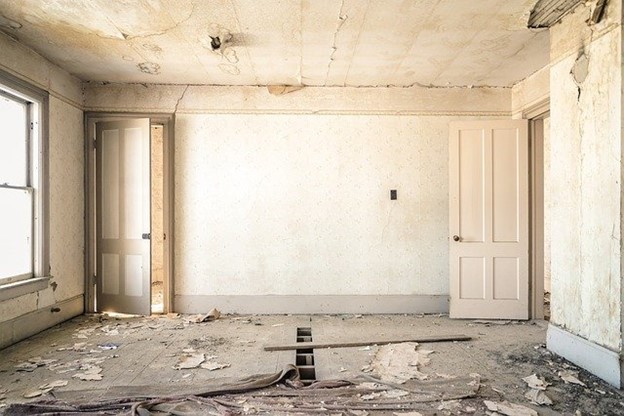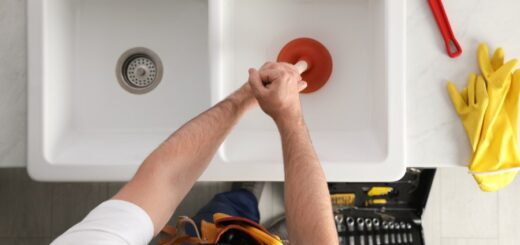How to Deal with Construction Dust Efficiently
Dust control is essential during renovation works. Most remodeling projects create a ton of dust in the form of dirt, drywall, sawdust, various debris, and more. The biggest mistake you can make during the process is to leave out the dust removal for last. Controlling the dust starts from the beginning of the job, and it’s something you need to pay attention to all the time. The excess dust accumulation is harmful to the property because it’s difficult to clean the rooms entirely in the end. However, it’s also detrimental to your health because breathing in construction dust for more extended periods can cause asthma, lung cancer, Chronic Obstructive Pulmonary Disease, and a lot more. Taking preventive actions can be lifesaving. Here are a few valuable tips:

Before you start the construction work
Protect the floors
There are many options to choose from when it comes to floor protection. Carpeting is especially prone to dust damage during remodels because the small particles can quickly get stuck to the soft fabric and settle in the padding for good. Wooden floors can also sustain damage during renovations, and they scratch easily when you drag heavy objects around. Invest in quality floor protection, including plastic covering, sticky mats, and corrugated plastic for areas with heavy traffic.
Cover or remove your property
None of your possessions are insured against damage during renovation works. The best way to protect your belongings is to remove them from the construction area, especially if they are personal or expensive. If there’s furniture you cannot move, just cover it with some plastic sheeting and avoid dropping heavy objects on top of it.
Seal the ducts
The fine dust particles can find their way through all kinds of small crevices, settling in them and contaminating the air for prolonged periods. Sealing the return ducts will prevent them from getting into the HVAC system, spreading them all around the house. By covering all the vents in the home, you will protect the house’s airflow and your furnace filter from clogging.
Isolate the work area
Don’t let the dust spread to areas you don’t renovate. Sometimes it’s impossible just to close a door and contain it in one room. If you’re renovating an open kitchen or stairwell, chances are the dust will spread everywhere. Fortunately, most home improvement stores sell plastic dust barriers; you can attach them to the walls and seal off the area from the rest of the house. Make sure there’s only one entry point to the construction works, and ask your contractors to carry out the messiest jobs outside, if possible.
Prepare your cleaning gear
There are a few cleaning items that you will find necessary during the process. Construction works come with a lot of dust and dirt, so, naturally, you’ll have to wipe or vacuum in between the sawing and the hammering. Here’s a list of the items you’ll need in your construction cleaning toolkit:
- A powerful vacuum + extra filters
- A broom
- A mop
- Old towels for bigger messes
- Soft towels for gentle surfaces
- All-purpose cleaner
- Wood polish
- Face masks and gloves
- A bucket for water or detergent
How to clean construction dust from walls
Unpainted walls
It’s best to clean walls before you paint them because otherwise, debris and dust can compromise the quality of the paint job. Make sure all the furniture is covered correctly before you proceed. First, use a broom to displace the more significant dust deposits. Then use a vacuum cleaner to gather all the dust from the walls and the floors. You might have to repeat these steps a few times because the dust has the habit of dispersing in the air and then settling back on the surfaces.
After that, you can optionally wash the walls, but it’s not mandatory since the place is new, the walls are not painted, and the paint can cover any minor stains. If you decide to wash them, use soapy water and a soft towel. Start from the top part of the wall and work your way down. This way, you won’t miss any spots and leave stains. Leave the walls to dry completely before painting.
Painted walls
If your walls are freshly painted, which is the usual case with renovation works, you will have to wait for the walls to dry completely before you can clean them from the dust. In this case, it’s not recommended to use a broom because it will damage the paint’s integrity. Use only a vacuum and try not to touch the surface of the walls. If there’s too much dust left after the vacuuming, you can use some plain warm water or slightly soapy water to wash away the remaining dirt. You can use a soft spongeA sponge is a porous material used to absorb liquids or clea... More or a towel to wipe them clean.
Wallpapered walls
Cleaning dust from wallpapered walls is quite simple. The only difficulty you could meet is if the surface of the wallpaper is embossed. The relief can capture dust and make it very difficult to clean. You’ll need to spend more time with the broom. First, use the broom or a brush to remove the dust lodged in the wallpaper. Then use a vacuum to clear out the walls and gather the dust you just irritated. If the room is big, you can work in sectors to ensure every part of the wallpaper is adequately taken care of. After that, you can wash the walls with some warm water and a soft towel if you still feel they’re dirty. Provide the room with proper ventilationVentilation is the process of exchanging or circulating air ... More to speed the dryingDrying is the process of removing moisture from materials, s... More process.
Wooden walls
Wooden walls are pretty durable and can resist all kinds of outside influences. Still, you need to be careful not to destroy the varnish in the process because it’s the only thing protecting the otherwise gentle wood. Start by dusting using a broom or a brush attachment on a vacuum cleaner. After that, use small amounts of warm soapy water and a gentle cloth to remove the remaining residueResidue is any leftover material, such as soot, dust, or che... More from the walls. You can also add a mild supplement to make the wood shinier and healthier looking.
How to remove construction dust from different types of flooring
Carpets and rugs
Dust on carpeted areas can be a real scourge. Don’t add water to the mix under any circumstances because this will make the situation even worse, maybe unrepairable. Water mixed with construction dust will turn into mud that will eventually stick to the carpet’s padding and destroy it. Vacuuming is the only thing that can help you save the carpets. Use a strong vacuum cleaner with a new filter, which will provide efficient airflow. You can use an upholstery attachment with a brush, it will pick up the dust, and the vacuum will gather it a lot easier. Set the vacuum to the highest suction option and slowly go through the entire carpet a couple of times. There’s a quick test to determine if there’s still dust on the rug: jump up and down. If no dust clouds are coming up, you’re probably good to go.
If you recently renovated your office, consider hiring a commercial carpet cleaning company; their expertly trained carpet cleaners are well versed in all carpet types and know how best to remove dirt and dust, especially after major construction projects.

Hardwood floors
Hardwood floors scratch all the time during remodels, so you need to proceed gently. Dusting the floor is the first step you need to take. Many vacuum cleaner attachments can be harsh on the floor, so you need to use a broom or a soft brush attachment. Once all the dust is gone, you can proceed to mop the floor with a soft towel and plain warm water. Leave it to dry, and in the end, polish the entire floor with a suitable wood polishing product. The polisher will leave the floor sparkling, and the dust won’t stick to it, which is a double win.
Laminate floors
Laminate flooringLaminate flooring is a type of flooring made of multiple lay... More is one of the most durable flooring options on the market so that it can withstand some dust and dirt during your home improvement efforts. Therefore, you can try all kinds of things to clean it and not have to worry about damage. Fellow Australian cleaning professionals recommend following steps similar to cleaning hardwood floors – dust and sweep first, then mop. You can use the vacuum to dust but be careful with the attachments again. The soft brush is still the best choice. Once all the dust is gone, use warm water with a gentle cleanser to mop the floor clean. After that, just dry with a soft towel to avoid any marks.
Tile floors
Many surfaces around the house are tiled – bathrooms, kitchen splash backs, the kitchen floor, etc. Many people think that pouring some water on the tiles is enough to remove the construction dust, but this is a widespread misconception because dust can get lodged in the grout and harden. The first thing you need to do is vacuum the floor or wall. Then fill a bucket of warm water and a mild tile cleaner and wipe the surface with a microfiber mop or cloth. After that, wipe and buff the tiles with a dry microfiber cloth for a shiny finish. Avoid using sponges because they are porousPorous describes a material that contains small openings or ... More and can miss some of the dirt. Use a circular motion while you clean tiles to avoid dust accumulation in the tracks and grout.












